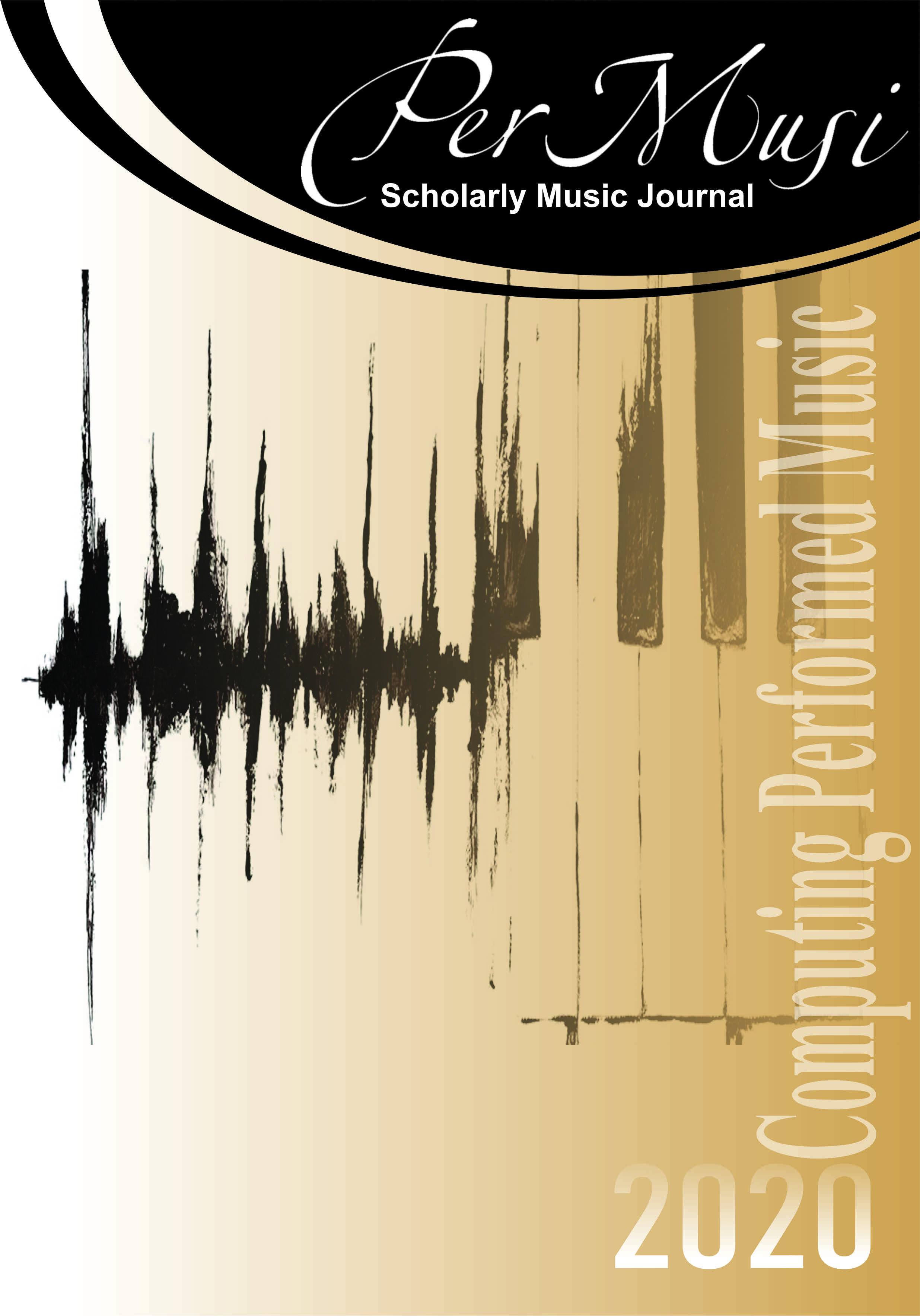Utilizando a teoria dos jogos para auxiliar a participação do público em performances artísticas digitais
DOI:
https://doi.org/10.35699/2317-6377.2020.32675Palavras-chave:
Performance Digital, Teoria dos jogos, Performance ao vivoResumo
A participação do público em performances artísticas tem sido alavancada pelo uso da tecnologia como elemento mediador entre público e artistas. No entanto, apenas a mediação tecnológica pode não ser o suficiente para garantir uma participação efetiva do público. Neste artigo, apresentamos a performance "O Chaos das 5", uma performance audiovisual com um forte suporte tecnológico que contou com o apoio da teoria dos jogos para alcançar uma participação mais efetiva do público em suas apresentações.
Referências
Araújo, João Teixeira, Paulo, Avner, Junior, Igino Silva, Schiavoni, Flávio, Canito, Mauro César Fachina, and Costa, Rômulo Augusto Vieira. 2019. A technical approach of the audience participation in the performance ’O Chaos das 5’. In Schiavoni, Flávio, Tavares, Tiago, Constante, Rogério, and Rossi, Régis, editors, Proceedings of the 17th Brazilian Symposium on Computer Music, 28–34, São João del‐Rei ‐ MG ‐ Brazil. Sociedade Brasileira de Computação.
Bin, S. Astrid, Bryan‐Kinns, Nick, and McPherson, Andrew P.. 2016. Skip the Pre‐Concert Demo: How Technical Familiarity and Musical Style Affect Audience Response. In Proceedings of the International Conference on New Interfaces for Musical Expression, volume 16 of 2220‐4806, 200–205, Brisbane, Australia. Queensland Conservatorium Griffith University.
Caillois, Roger. 1990. Os jogos e os homens: A máscara e a vertigem. Editora Cotovia, 1st edition.
Collins, Nick, McLean, Alex, Rohrhuber, Julian, and Ward, Adrian. 2003. Live coding in laptop performance. Organised sound, 8(3):321–330.
de Carvalho Junior, Antonio Deusany, Lee, Sang Won, and Essl, Georg. 2016. Understanding Cloud Support for the Audience Participation Concert Performance of Crowd in C[loud]. In Proceedings of the International Conference on New Interfaces for Musical Expression, volume 16 of 2220‐4806, 176–181, Brisbane, Australia. Queensland Conservatorium Griffith University.
Egozy, Eran and Lee, Eun Young. 2018. *12*: Mobile Phone‐Based Audience Participation in a Chamber Music Performance. In Luke Dahl, Douglas Bowman, Thomas Martin, editor, Proceedings of the International Conference on New Interfaces for Musical Expression, 7–12, Blacksburg, Virginia, USA. Virginia Tech.
Hindle, Abram. 2013. SWARMED: Captive Portals, Mobile Devices, and Audience Participation in Multi‐User Music Performance. In Proceedings of the International Conference on New Interfaces for Musical Expres‐ sion, 174–179, Daejeon, Republic of Korea. Graduate School of Culture Technology, KAIST.
Huizinga, J.. 2010. Homo Ludens. Editora Perspectiva, 6th edition.
Junior, Igino, Schiavoni, Flávio, Siqueira, Adilson, and Almeida, Marcela. 2019. A interatividade d’ ”O Chaos das 5”. In Anais do 5o. Seminário de Artes Digitais 2019.
Lee, Sang Won and Freeman, Jason. 2013. echobo : Audience Participation Using The Mobile Music Instru‐ ment. In Proceedings of the International Conference on New Interfaces for Musical Expression, 450–455, Daejeon, Republic of Korea. Graduate School of Culture Technology, KAIST.
Mazzanti, Dario, Zappi, Victor, Caldwell, Darwin G, and Brogni, Andrea. 2014. Augmented Stage for Partici‐ patory Performances. In NIME, 29–34.
McGonigal, Jane. 2010. TED Talk: Jogando por um mundo melhor.
Rancière, J. and Elliott, G.. 2009. The Emancipated Spectator. Verso.
Rauen, Margie. 2011. Participação: o Ex‐público e o Ativismo. Anais ABRACE, 12(1).
Ribeiro, Fernando Cesar. 2010. Action painting, happening e performance art: da ação como fator significante à ação como obra nas artes visuais. Visualidades, 8(2).
Rocha, Cleomar. 2005. O imaterial e a arte interativa. DOMINGUES, Diana. VENTURELLI, Suzete.(org.). Criação e poéticas digitais. Caxias do Sul: Edusc, 27–31.
Santos, José Mário Peixoto. 2008. Breve histórico da “performance art” no Brasil e no mundo. Revista Ohun, 4(4):1–32.
Taylor, Benjamin. 2017. A History of the Audience as a Speaker Array. In Proceedings of the International Conference on New Interfaces for Musical Expression, 481–486, Copenhagen, Denmark. Aalborg University Copenhagen.
Vieira, Rômulo, de Oliveira Júnior, Igino, Almeida, Marcela, and Schiavoni, Flávio Luiz. 2020. Uma aproximação entre participação do público em espetáculo artístico e jogos: racionalidade e improviso. In Proceedings of SBGames 2020, 116–124, Recife, PE, Brasil. SBC.
Zehnder, Sean and Lipscomb, Scott. 2006. The role of music in video games. Playing video games: motives, responses, and consequences, 241–7.
Downloads
Publicado
Edição
Seção
Licença
Copyright (c) 2021 Per Musi

Este trabalho está licenciado sob uma licença Creative Commons Attribution 4.0 International License.

Exceto onde está indicado, o conteúdo neste site está sob uma Licença Creative Commons - Atribuição 4.0 Internacional.












